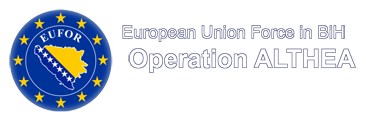The EUFOR team tackling the mine threat - great achievements so far but still work to do
In a small office in an outbuilding of EUFOR HQ sits the EUFOR Mine Information Coordination Cell (MICC). They are a sub-section of Joint Military Affairs’ Countermine Team, and part of the Capacity Building and Training Division of EUFOR’s Op Althea. With only a small team consisting of local civilians and a Military Officer, Lieutenant Colonel Horst Unterrieder, as team leader, their mandate is clear - force protection of EUFOR personnel against the threat of mines and unexploded explosive ordnance (UXO).

LOT and AF BiH Staff delivering MRE to children using MICC produced items.
As part of MICC’s force protection mandate, a vital part of their role is to survey areas before the start of exercises to ensure the troops are given the most recent information in order to be as safe as possible. When not directly preparing areas for the military force, the everyday work is broadly split into education of personnel and coordinating information to create useful reference material.
Dzejna Skopljak leads the education elements, delivering the majority of the Mine Awareness Training (MAT) lectures as well as providing the teaching information and material to the Liaison and Observation Teams (LOTs), who deliver the Mine Risk Education (MRE) lectures. She is a familiar face on the camp as every EUFOR employee is obligated to receive the MAT lecture.
Mine Risk Education provides children and personnel in at-risk areas or jobs with the knowledge of the possible threat and how best to avoid it. The content is delivered by EUFOR’s LOTs and closely regulated by the BiH Government to international standards. Each LOT is provided with an educational ‘package’ so they are able to travel to schools, workplaces and homes to give the presentations to those who need it. Promotional materials containing mine awareness slogans are seen by the MICC as being particularly useful in driving home the key messages to the population. Recently, LOTs have been conducting joint MRE lectures with the Armed Forces BiH in order to enhance the country’s ability to operate independently, part of the Capacity Building and Training mandate of EUFOR.
Mine Awareness Training differs from MRE in that it provides EUFOR personnel with the same key messages, but also includes guidance on how a person can remove themselves as safely as possible from a mined area should they find themselves in one.
Milad Cerimagic is the lead for coordinating the mine information. He works closely with the BiH Mine Action Center (BHMAC), taking their most up-to-date information and converting it into a usable format for EUFOR to exploit. He produces standard map sizes for dissemination as posters and promotional material but also can give anyone, on request, a detailed map of a specific area anywhere in the country. These maps can go right down to 1:5000 scale for exceptional resolution of the terrain. Some of the information they can include is known mine incidents, mine records, cleared areas, lifted areas and places where landslides may have occurred. The MICC data is updated monthly from the BHMAC database.
In order to keep the threat intelligence as near-real-time as possible, information can also flow the other way. If someone finds a discrepancy with the information provided, e.g. lack of signs where there should be or an area marked on the ground which isn’t on the maps, this information can be reported to the MICC who then check the records with BHMAC and amend as necessary.
MAT and Mine Maps are primarily for EUFOR personnel but can be provided to members of the international community on request. Mr Cerimagic wanted to stress to EUFOR personnel that “the mine threat is real so whatever outdoor activity you wish to do, make sure you get the right information and educate yourself on the possible threat”.
Another service the team can provide is the production and dissemination of information materials at short notice. During the recent floods in 2014, many mine signs and mines themselves were displaced with the volume of surface water. The public had to be made aware of this increased risk so the MICC made posters outlining the threat and were able to get them into the public sphere very quickly.
The MICC team are very proud of the fact that since Mine Awareness Training became mandatory for all EUFOR personnel in 2001 there have been no mine related casualties on the mission.
When discussing the team’s role they told an old good-news story for MRE which came about in the early 2000s. Two children were tending sheep and they came across an interesting object. The elder sister was prevented from disturbing it by her younger brother who told her not to touch it, an action which ultimately saved their lives. They called their parents and the object turned out to be a landmine. The boy said he knew what to do from a MRE lecture at his school the previous year.
In 2016:
- 20,611 children and personnel in at-risk areas receive EUFOR Mine Risk Education.
- 5,657 mine maps were produced and distributed by the team.
- 1,291 received Mine Awareness Training, most of whom were EUFOR soldiers.
Conservative estimates for the number of people still affected by mines, i.e. living or working in risk areas, is stated as 538,500, with the number of communities affected at around 1,417. There are still 1,141.1km2 of suspected hazardous areas for mines throughout the country.
